
Scales on the ukelele
Content
Major scales on the ukuleleNatural minor scales on the ukulele
Harmonic minor scales on the ukulele
Melodic minor scales. Scales comparison
A commentary about the practice of scales
In the Fretboad section we completed the location of the musical notes on the fretboard of the ukulele, so that we have two octaves of notes on its fretboard, which begin in note A3 of the open third string and culminate in note A5 in the twelfth fret of the first string. We are now able to deal with the execution of scales on this instrument.
Scales are the basis for the development of melodies and harmonies and were studied in the Scales section of the Theory page. In this page we will elaborate the fingering of some scales on the ukulele fingerboard.
The search for notes carried out in the Musical notes section of the Theory page led to the tempered chromatic scale used in Western music, which we now present with the note C4 as the first note and using colors to distinguish natural notes:

Due to their enormous importance, it is good to remember now the conformation of the major scales:

The possible fingerings for the different scales of each of the twelve notes used in Western music are so numerous that a rational approach is required for their treatment. In these pages we will use the following criteria and observations to develop a representative set of possible fingerings:
- Only scales the first degree of which is a natural grade are considered. The scales for sustained or flat notes can be obtained, possibly with a few changes, by raising or lowering a fret the fingering for the corresponding natural note.
- Since they are sufficient for the study of the different melodies considered in these pages, only the major scales and the minor scales are considered.
- Since the major scales are fundamental and the other types of scales can be obtained from them by altering some of their notes, they must form the basis for the selection of fingerings.
- The fingerings of scales located at the top of the fretboard are easy to enter since they have notes in open strings, so they are a good choice to begin the creation of the set of fingerings.
- While fingerings with air strings are useful and easily executed, they differ in the distribution of their notes on the fingerboard, which makes it difficult to select a minimum group of fingerings sufficient to generate all scales. In this page we will make this selection taking into account that:
- We will limit ourselves to fingerings on the first three strings, so the selection must be made so that each of the fingerings contains grades I, III and V that constitute the major triads.
- The set generated is such that the first grade can be placed on each of these first three strings.Therefore the appropriate minimum set will consist of three general fingerings.
- The selection of fingerings should be such that they can be linked to sweep the entire fingerboard.
If you carefully study the process based on the previous points and elaborated in the following sections, you will be able to apply these ideas to the construction of other scale fingerings.
Major scales on the ukulele
The major scales are the basis upon which much of the theory of music in Western civilization is built. They were studied in the Scales section of the Theory page.
Open position major scales on the ukulele fingerboard
The major scales for the seven natural notes are illustrated below. For the reasons given in the previous section, these scales are fingered on the first three strings, on which the constitutive notes appear with a normal stroke; however, the notes of the scale on the fourth string are also shown, but in a clear stroke. You could use these last notes to elaborate additional fingering.
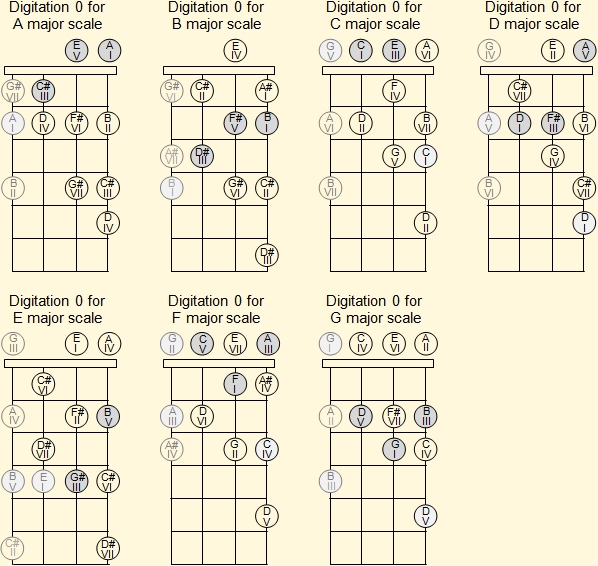
A very important aspect of these diagrams is that for each scale fingering the notes of the corresponding major chord, consisting of degrees I, III and V, have been shaded. The theory corresponding to the chords is studied in the Chords section of the Theory page, at this point we will only point out that they play a fundamental role in the accompaniment of melodies.
At the end of the previous section we provided the score of the melody of "Twinkle, Twinkle, Little Star" in the key of C major. Let us suppose that we wish to interpret this melody in the key of D major. In order to transport C major to D major, we simply raise two semitones for each of the notes, thus maintaining the same sequence of degrees. We use the same sequence of degrees used for this melody in C major, but we take the notes corresponding to these degrees of Digitation 0 for the scale of D major:
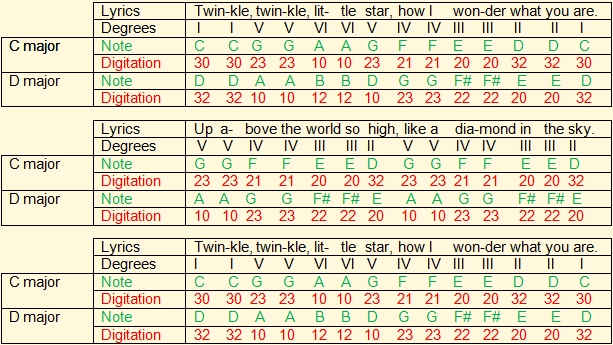
Note the shaded notes in the diagrams for the C major and D major scales: the chord that underlies both scales has shifted two frets down in the second. When we study the chords in the next section we will see the importance of being able to visualize these chords.
Minimum set of basic fingerings for major scales
From the observation of this set of fingerings it is concluded that there is a minimum of three major triads (constituted by the notes corresponding to grades I, III and V) whose tonics appear on the first to third strings of the ukulele; the shaded ones on the major scales for the A, D and F tonalities:

Note that the nucleus of these fingerings are major triads constituted by the notes corresponding to degrees I, III and V, and whose tonics appear on the first to third strings of the ukulele; the shaded ones on the major scales for the B, E and G tonalities. Also note that the content in the last fret of one fingering is identical to the content in the first fret of the next.
Fingering of major scales along the fingerboard of the ukulele
The knowledge of how to finger the different scales throughout the fretboard greatly facilitates the fingerpicking of melodies and their transport to a different tonality. Below is an example that illustrates the use of these fingerings for transportation.
We have considered the interpretation of "Twinkle, Twinkle, Little Star" in the key of C major. This is a very appropriate tonality for the ukulele because the second to fourth open strings produce the notes E, C and G corresponding to degrees III, I and V of the C major scale, respectively, the most important of this scale, and in addition these notes constitute the C major chord, one of the easiest fingering. The following figure shows the fingerings link to generate the major scale for the C tonality and the major scales for its subdominant (IV, F) and dominant (V, G) degrees:
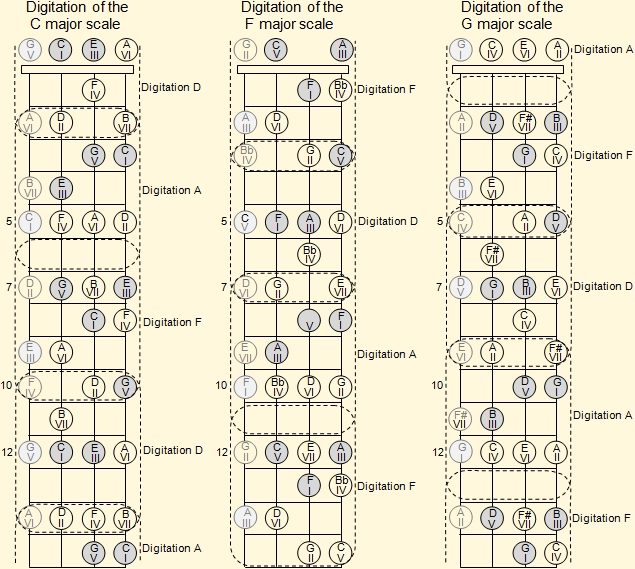
The key of F major is another whose main chords are very easy to finger in the ukulele. Below is the transcription of "Twinkle, Twinkle, Little Star" from C to F, obtained by simple comparison of the fingerings of the different degrees of the open C and F major scales:
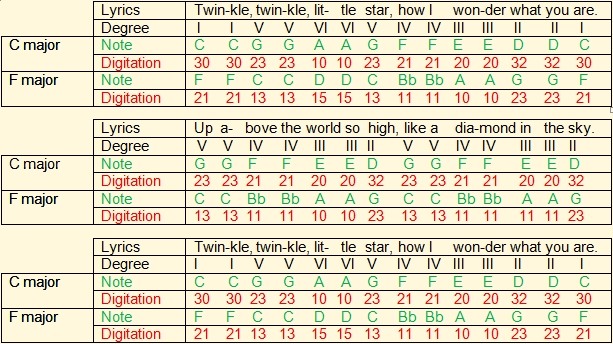
Another way to obtain a transcription of C to F is simply to lower the C major fingering down five frets on the fretboard:
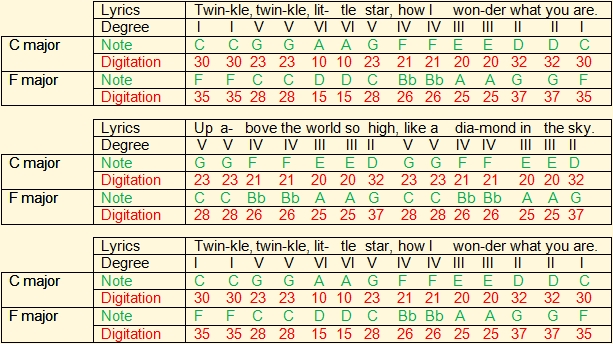
When comparing these results with those of the previous transport, we see that the latter is much simpler to elaborate, since each note is typed on the same string and five frets below on the fretboard. This is the reason why in the literature the conformations of notes such as our fingerings Digitation D, Digitation A and Digitation F are called "movable formations". It is very easy to use the analogy of the clock to calculate the number of frets that a finger has to move to transport to a new tonality:
Displacement in frets = hour of new tonality (+ 12) - hour of original tonality
12 will be added to the hour of the new tonality if it is less than the hour corresponding to the original tonality, so that the result is positive. In this case the displacement will be up on the fretboard, otherwise it will be down.
Commentary: the transport by means of "mobile formations" is so simple that in reality it is not necessary to elaborate a table with the digitations, it is enough to go up and down on the fingerboard according to the result of the previous calculation. This table was elaborated for demonstration and comparison purposes..
Minor scales
Natural minor scales on the ukulele
The natural minor scales were studied in the Minor scales subsection of the Theory / Scales.
In the minor scales the third grade is three semitones, third minor interval, of the tonic. This small difference with respect to the major scales, in which it is at a third major interval, by itself, makes a big difference in the mode of these scales: while works developed on the basis of the major scales usually manifest a festive spirit, the works developed on the basis of a smaller scale usually manifest a melancholic spirit.
Below is the natural minor C scale:

Relationship between natural minor natural scales and major scales
Every major scale corresponds to a natural minor relative scale that has the same degrees and is constructed from its sixth grade; therefore, what has been studied for major scales greatly facilitates the generation of natural minor scales. It also facilitates the construction of other types of scale, since these can be generated by deletion or alteration of notes of their corresponding major scales.
Open position natural minor scales
The minor scales for the seven natural notes are illustrated below. For the same reasons given for the major scales, these scales are fingered on the first three strings. The constitutive notes on these first three strings appear with a normal stroke; however, the notes of the scale on the fourth string are also shown, but in a clear stroke. You could use these last notes to elaborate additional fingering.
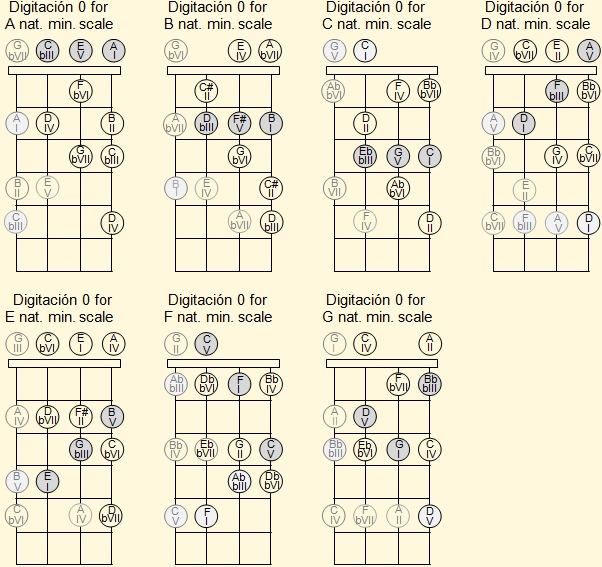
Minimum set of basic digitations for natural minor scales
From the observation of the set of digitations for the minor scales corresponding to the natural notes it is concluded that the following set of digitations are sufficient to generate all the minor scales:
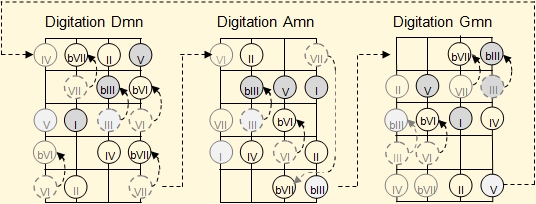
The figure shows that these basic fingerings for minor scales can be obtained from the basic fingerings for major scales by altering the notes for degrees III, VI and VII. Note that the nucleus of these fingerings are minor triads constituted by the notes corresponding to degrees I, bIII and V, and whose tonics appear on the first to third strings of the ukulele; the shades on the minor scales for B, E and G tonalities. Also note that the content on the last fret of a digitation is identical to the content on the first fret of the next.
Below we present the transcription of a simple arrangement of the melody of "Greensleeves" in A minor.
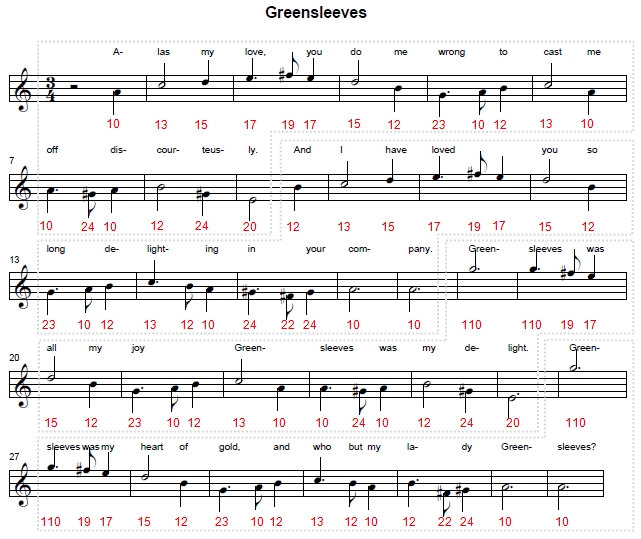
You can play the following video to see the pickering of this melody:
Although the interpretation of this arrangement is not particularly difficult, it has the disadvantage that it requires displacements over almost the entire length of the fretboard. This problem can be lessened by using notes of the natural minor scale of La in other fingerboard positions.
Next we will see how to digitate natural minor scales along the fretboard, among them the scale corresponding to the one that now occupies us.
Fingering of natural minor scales along the ukulele fretboard
The following figure shows the link of these fingerings to generate the natural minor scale for the A tonality and natural minor scales for its subdominant (IV, Re) and dominant (V, E) degrees.
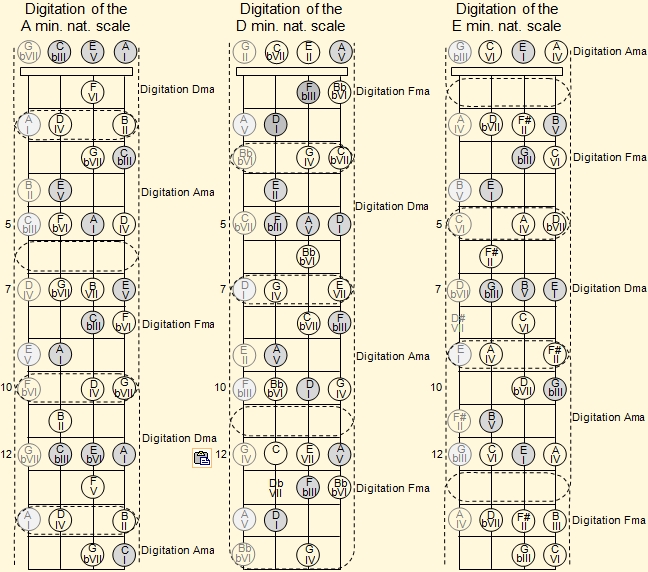
Next we will use the diagram corresponding to the A natural minor scale to generate an arrangement in this same tonality but that does not require displacements as wide as that of the previous section. The procedure is analogous to that used in the "Twinkle, Twinkle, Little Star" transcripts: we create a table in which the source arrangement is registered and a row is added in which the new fingerings are recorded. The table is now simpler since the tonality is maintained.
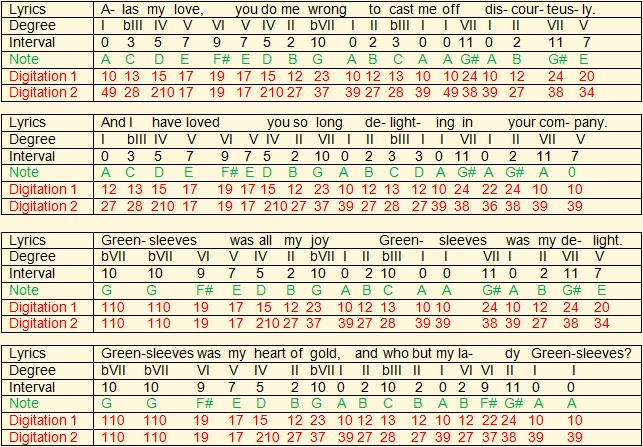
Note that the new fingering develops around the basic Dmn fingering located at 7th to 9th frets.
Harmonic minor scales on the ukulele
The harmonic minor scales were studied in the Minor scales section of the Theory / Scales section.
In this section we will consider the harmonic minor scales, which have the advantage over the natural ones that their seventh grade is not altered and has a leading nature, so it tends to resolve the tonic more strongly; however, remember that the key signature for this and other minor scales is fixed by the natural minor scale.
Harmonic minor scales in open position
The harmonic minor scales for the seven natural notes are illustrated below.
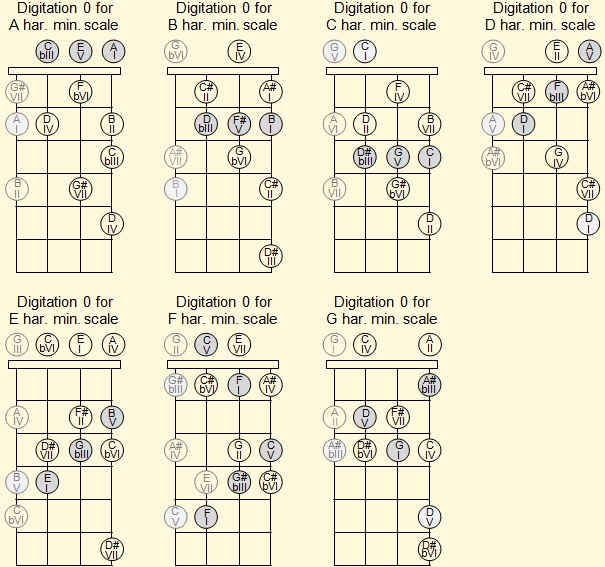
Minimum set of basic digitations for harmonic minor scales
The following illustrates how basic digitations for major scales are altered to generate basic digitations for harmonic minor scales:
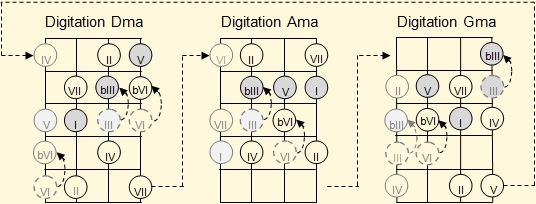
Digitations of minor harmonic scales along the ukulele fretboard
The following figure shows the link of these fingerings to generate the harmonic minor scale for the A tonality and the harmonic minor scales for its subdominant (IV, Re) and dominant (V, E) degrees. This figure can be easily generated from the one corresponding to the link of the fingerings for the natural minor scales, simply by raising a semitone the note corresponding to the seventh grade to make it leading.
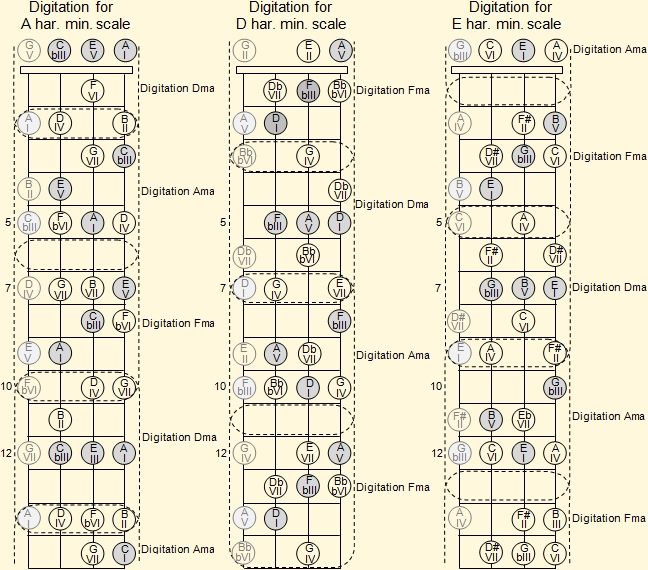
Next we will use the diagram corresponding to the A harmonic minor scale to generate an arrangement in this same tonality but that does not require displacements as wide as that of the previous section. The procedure is analogous to that used in the "Twinkle, Twinkle, Little Star" transcripts: we create a table in which the source arrangement is registered and a row is added in which the new fingerings are recorded. The table is now simpler since the tone is maintained.
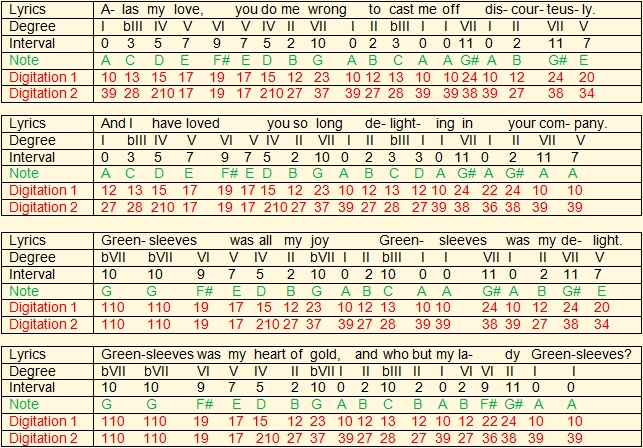
Note that the new fingering develops around the basic Dma fingering located at 7th to 9th frets. The only note that is not fingered in this range is the lowest melody note, the E4 note, which culminates the first and third sentences and is fingered on the seventh fret of the fourth string. Now, since the note A is associated with the note E4 (hour nine in the clock analogy), once you have mastered the fingering of "Greensleeves" by means of the basic fingering Fma you can easily interpret it in the minor tones that go from A to D minor to Re minor, since 9 - 7 = 2.

Remember: finger 1 is the index finger, 2 is the middle finger, 3 is the ring finger and 4 is the pinky finger.
Melodic minor scales. Summary of the composition of scales
In the Scales section of the Theory page it was explained that the melodic minor scale solves the problem of the separation of three semitones between degrees bVI and VII and of the harmonic scale.
Also in the Scales section of the Theory the composition of the different scales considered in this page was summarized in the following table:
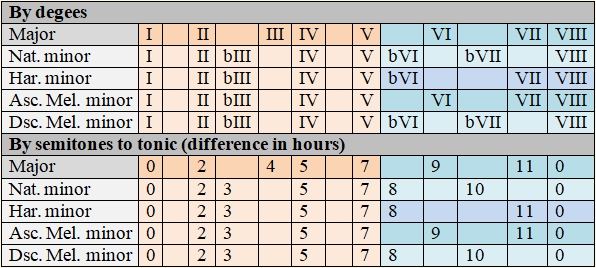
Since the first five notes of both melodic scales are identical to those of the natural minor and harmonic minor scales, the last three notes of the ascending melodic minor scale are identical to the last three of the major scale, and the last three notes of the Melodic minor scale descending are identical to those of the natural minor scale, it is not necessary to develop the digitation diagrams for the melodic minor scales. If the reader so wishes, he can carry out the following optional exercise:
A commentary on the practice of scales
A complete familiarization with a large number of scales is a process that requires a lot of exercise. In this page we have overlooked the aspect of exercising scales since the interest focused on indicating their importance in becoming familiar with the fretboard of the ukulele and in the execution of melodies. The practice of scales is crucial if you are interested in playing solos on the ukulele, aspect studied in the last chapter.
If you are a beginner in the study of the ukulele, probably your initial interest will be only to be able to accompany melodies using this instrument. For this, it is essential that you become familiar with chord fingerings, an aspect that we will study in the next chapter. In fact, we have already prepared the way for the study of chords: when studying the different digitation of scales we have highlighted the major and minor chords around which these digitations are constructed. These major and minor chords are the most important, and will allow you to accompany a large number of simple melodies.
Various